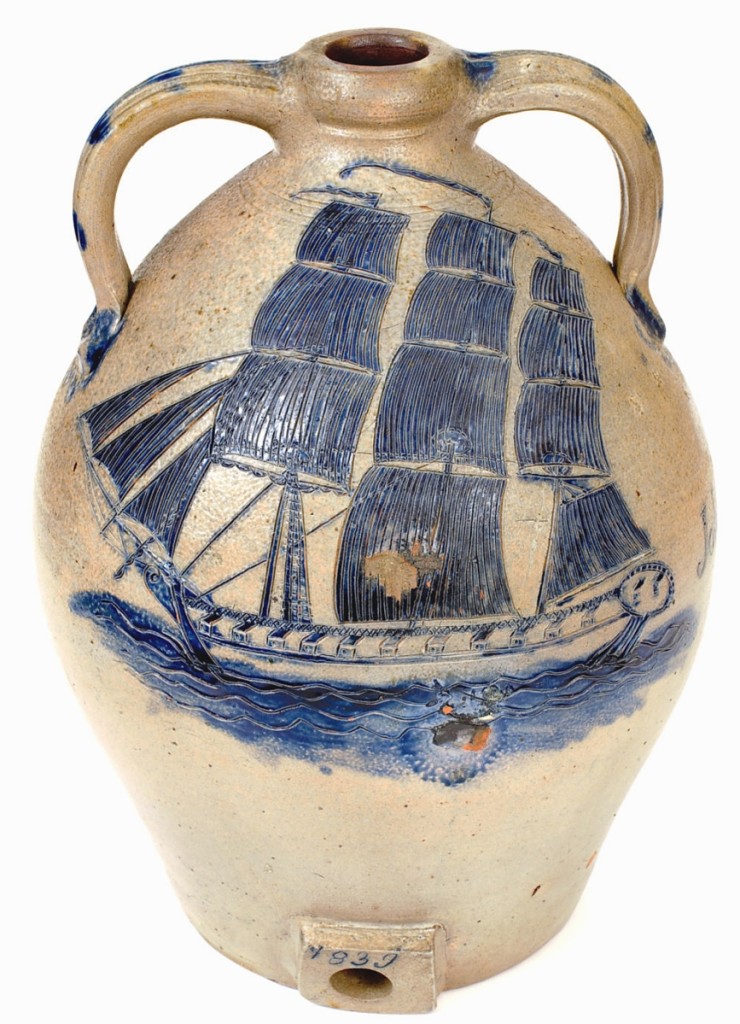
The sale’s top lot at $252,000 was this stoneware cooler attributed to South Amboy, N.J., potter Abial Price. It is only the sixth piece of stoneware to crack the $200,000 mark at auction and it sets a record for New Jersey stoneware. The piece is dated 1839 and features the name of “John B. Wilson,” to whom it was likely presented. The firm said it was the finest sailing vessel design they had ever seen on a piece of pottery, notable for the incising on the ship, sails and water.
Review by Greg Smith, Photos Courtesy Crocker Farm
SPARKS, MD. – Crocker Farm’s third and final auction of 2020 reached over the $1 million mark and capped off a record year for the firm as it tallied just under $3.5 million in annual sales.
“We were thrilled with the prices for this auction, but more thrilled with the market for quality stoneware of all regions,” partner Mark Zipp said. “There wasn’t a single place where I can point out softness. It really bodes well for 2021.”
Bidders have grown comfortable with the firm’s timed online format, which closes online at a set time and is followed by callbacks for any lot over $2,000. The sale ran from November 20 to December 4 and, when the dust settled, it had produced a record for New Jersey stoneware.
Selling for $252,000 to a private New Jersey collector was a 4-gallon stoneware cooler attributed to South Amboy, N.J., potter Abial Price, who came from a tradition of potters in his father, Ebenezer, and his more widely-known grandfather, Xerxes.
Zipp said it was the finest ship design he had ever seen on a piece of pottery, notable for the intricacy and depth of the incising. It featured a three-masted sailing vessel, double open handles, a date of 1839 and the name “John B. Wilson,” to whom it was likely presented. To the reverse is a tulip flanked by leaves in the form of a wreath, a known design that Price used and the clue that ultimately led to its attribution. The cooler is only the sixth piece of stoneware to break the $200,000 mark at auction.
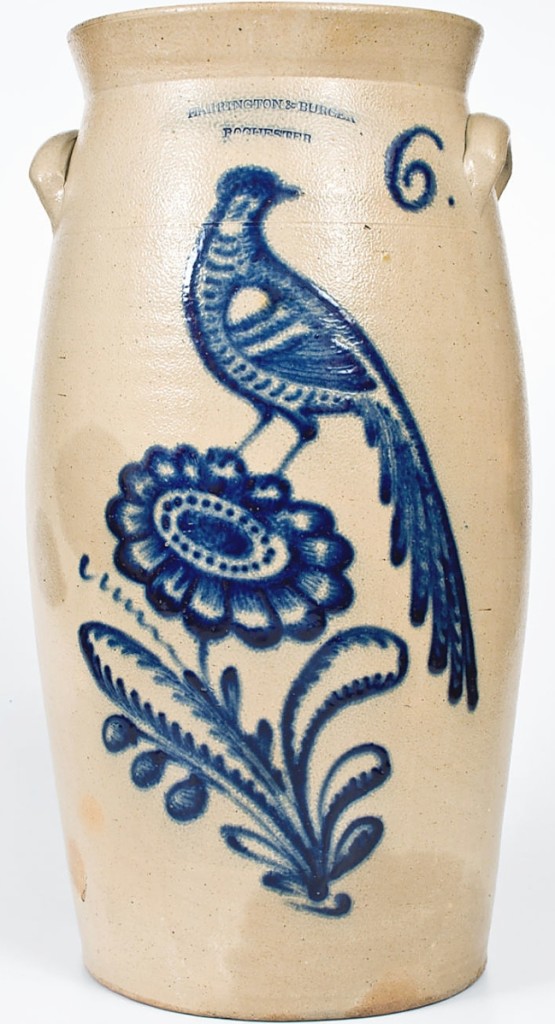
Rochester, N.Y., pottery was hot with two examples blowing through their estimates in this sale, this churn from Harrington & Burger selling for $48,000. Mark Zipp said, “Burger is considered a master of sliptrail decoration. For people who are real students of Rochester stoneware, they recognized how rare that bird design was; there are only four or five pheasants known by him. It’s rare.”
Two pieces of Rochester, N.Y., stoneware found spirited bidding and both were fresh to market examples from a Brooklyn, N.Y., collection.
“We were contacted by an elderly gentleman several years ago,” Zipp said. “He was talking to me about his collection and he told me he wanted us to sell these things when he passed. We got a call out of the blue this fall and they came in. Nobody was familiar with this collector, so it was kind of neat to have fresh stuff – it’s something we always strive to have. For every sale, something comes out of nowhere.”
Among them was a $48,000 result for a Harrington & Burger stoneware churn, 21 inches tall, featuring a large cobalt-decorated pheasant on a flower. On the decoration, the auction house wrote that it was unquestionably in Burger’s hand.
“Rochester stoneware has always been some of the most collectible and desirable American pottery because of the decorative quality,” Zipp said. “Stetzenmeyer and Burger, both of the Rochester schools, their pieces are decorated with designs that border on fine art. It’s remarkable these things were made to be used.
“Burger is considered a master of sliptrail decoration. For people who are real students of Rochester stoneware, they recognized how rare that bird design was, there are only four or five pheasants known by him. It’s rare.”
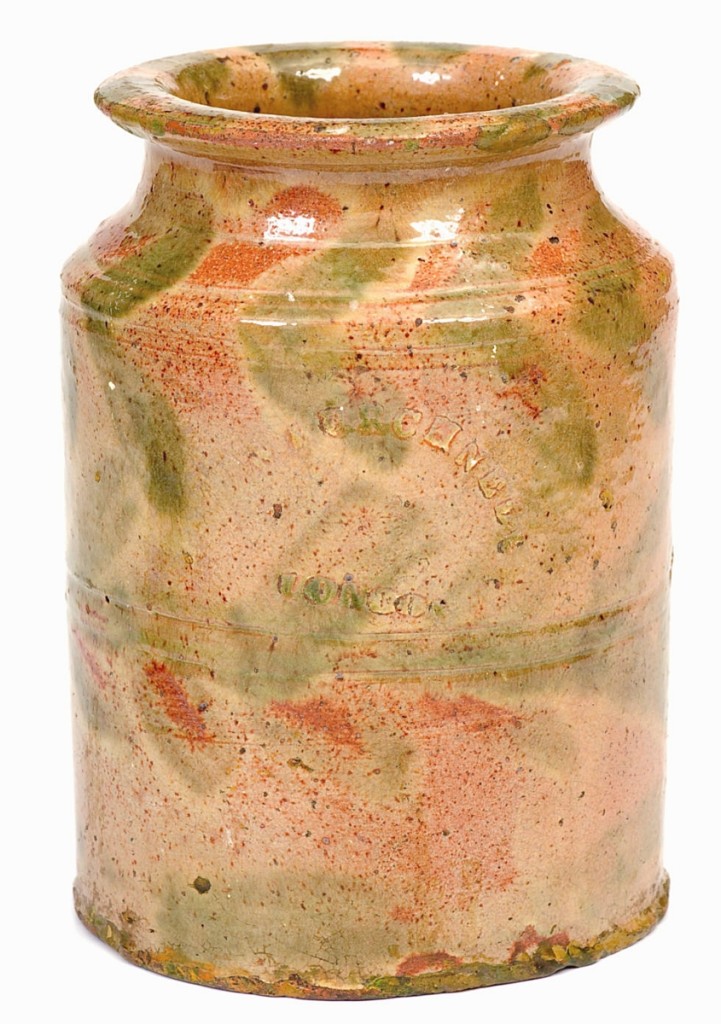
Ohio redware has a new benchmark with the $36,000 result on this William Burchnell jar, produced by the potter circa 1835 in London, Ohio. Zipp called it Burchnell’s masterpiece, noting that other known works from the potter do not come close to the dynamic glaze exhibited here.
Behind at $26,400 was a Burger 5-gallon stoneware crock from the same collection. It featured a cobalt-decorated cornucopia design and dated to 1860. The auction house noted that other Rochester-trained potters copied Burger’s design as they traveled westward to Ohio. This was the first example by the potter bearing this design that Crocker Farm had handled.
“The market bodes well for exceptional slip trail designs from the Northeast,” Zipp noted. “There seems to be a resurgence in that market that we’ve never seen before. There was a period when the Northern pottery got soft, but it’s actually bounced back and gone above what it was.”
A redware jar with green foliate decoration by Morgantown, Va.-trained William Burchnell made a reappearance at the firm and sold for $36,000. Crocker Farm had sold it to the consignor in 2009 for $6,440. It was produced circa 1835 in London, Ohio, where Burchnell had established a pottery on the grounds of a Presbyterian Church five years prior in partnership with James M. Thompson Jr.
“This was that potter’s masterpiece as far as what survived,” Zipp said, noting that only a few examples of Burchnell-signed pottery are known. “And they’re all fairly simply glazed,” he said, “many of them with a dipped glaze. That this had brushed vining on it was remarkable.” It was pushed over the $9,000 high estimate by two collectors who took interest in the potter’s works and established a record for Ohio redware.
A number of works with political messaging were featured in the sale. Top among them at $20,400 was a 6-gallon stoneware crock from Ohio dating to 1868 and depicting an image of New York Governor and Democratic candidate Horatio Seymour, who ran a categorically racist campaign with Union Major General Francis Blair as his running mate. It was the first election since the abolition of slavery and the first that Blacks could vote in. Seymour was rejected by the populace in a 214-80 landslide electoral victory for Ulysses S. Grant. Next to the image of Seymour is written “I am going up Salt River! Where are you going Frank.” The phrase “Going Up Salt River” refers to political oblivion, a path of defeat that leads to nothing and nowhere. It was coined by Ohio Representative, Alexander Duncan when he used it in a House of Representatives speech. Selling for $10,200 was an Ohio stoneware flask that read “Grant / 45000 in / Ohio / Nov 3rd / 1868” and “H / C=Mour / will meat(sic) my Friends up / Salt River / Nov 4th / 1868.” The “45000” referenced the amount of votes that Grant won Ohio by and the flask was in excellent condition.
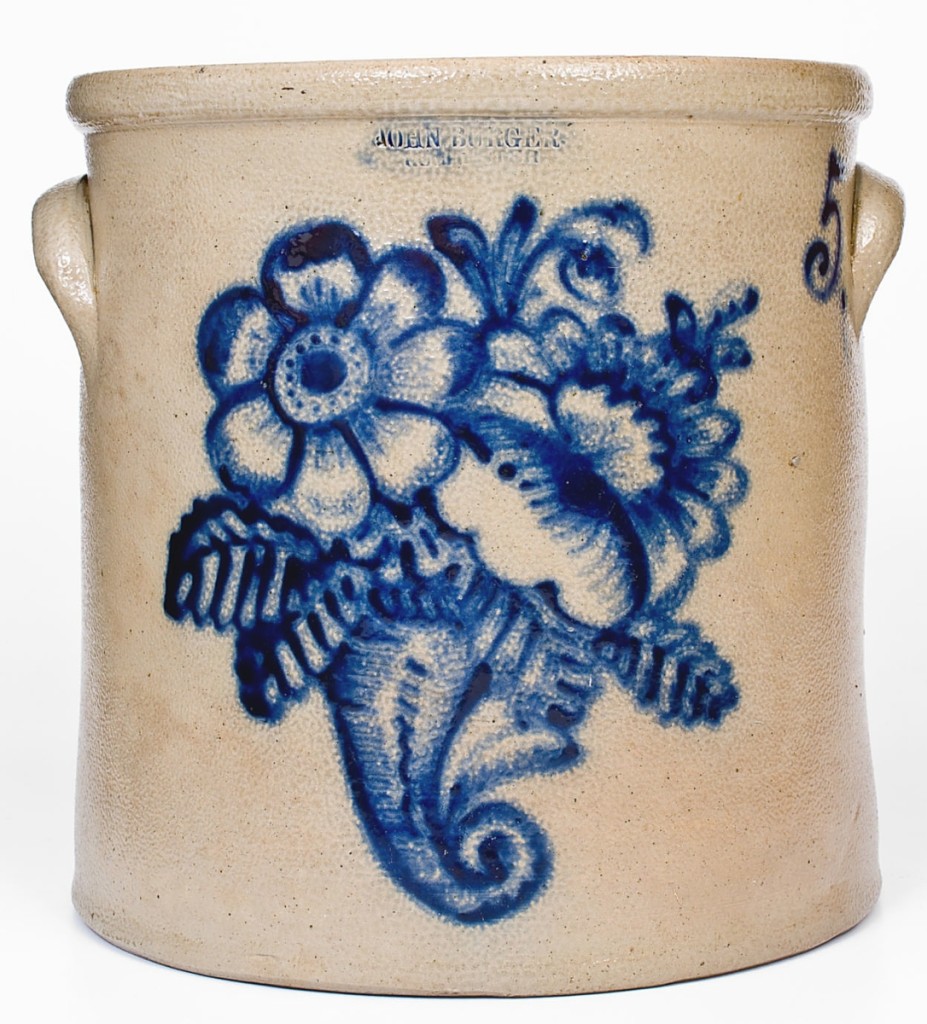
Taking $26,400 was this 5-gallon stoneware crock from Rochester, N.Y., potter John Burger. Two dedicated collectors pushed it well beyond the $6,000 high estimate, due in part to the fact that the design is a rare one for the potter.
Zipp said that he was particularly fond of an Anna Pottery pig bottle that referenced the father of American cartoons, Thomas Nast, who gained his reputation for his illustrations in Harper’s Weekly. Nast was particularly known for his political satire, of which the Kirkpatrick brothers were fond of.
“Before this pig was made, the Kirkpatricks made a famous jug for Nast in 1871,” Zipp said. “It’s an important piece, one of their masterworks, featuring snakes with human heads representing different members of the Boss Tweed ring. It made its way to Nast and was gifted to the New-York Historical Society by Nast’s widow and it’s still there.”
The Kirkpatricks explored political satire in many of their works and were apparently fond of Nast until they seem to have soured on him in 1884, the year this pig was made and Nast flipped his political leanings to support the Democrat Grover Cleveland in that year’s presidential election. While the pig features a railroad map for the Midwestern United States, it features the inscription “Nast turning summersalts(sic),” with incised image of a man with a donkey’s head in the act of somersaulting. According to the consignor, it never left Illinois and it is unknown whether the Kirkpatricks ever intended for Nast to see it. It sold for $10,800.
Even higher at $14,400 was an addenda log of a redware pig stamped for Reading, Penn., potter Daniel Peter Shenfelder. It featured a yellow body slip with brown and green spotting on its back. The firm was only able to find one other pig from the potter in a 1982 Sotheby’s sale from the collection of Pauline Heilman.
Also notable among redware was an 11¼-inch copper and manganese glazed jug with a Maine origin that sold for $12,000.
“That came from a grouping out of Long Island,” Zipp said. “The consignor said she was moving and wanted to sell a few things and that piece really stood out. It’s a record or near record price for a New England redware jug. The juxtaposition of the green topper glaze over the brown manganese glaze was unusual. The splashing created a really dynamic aesthetic.”
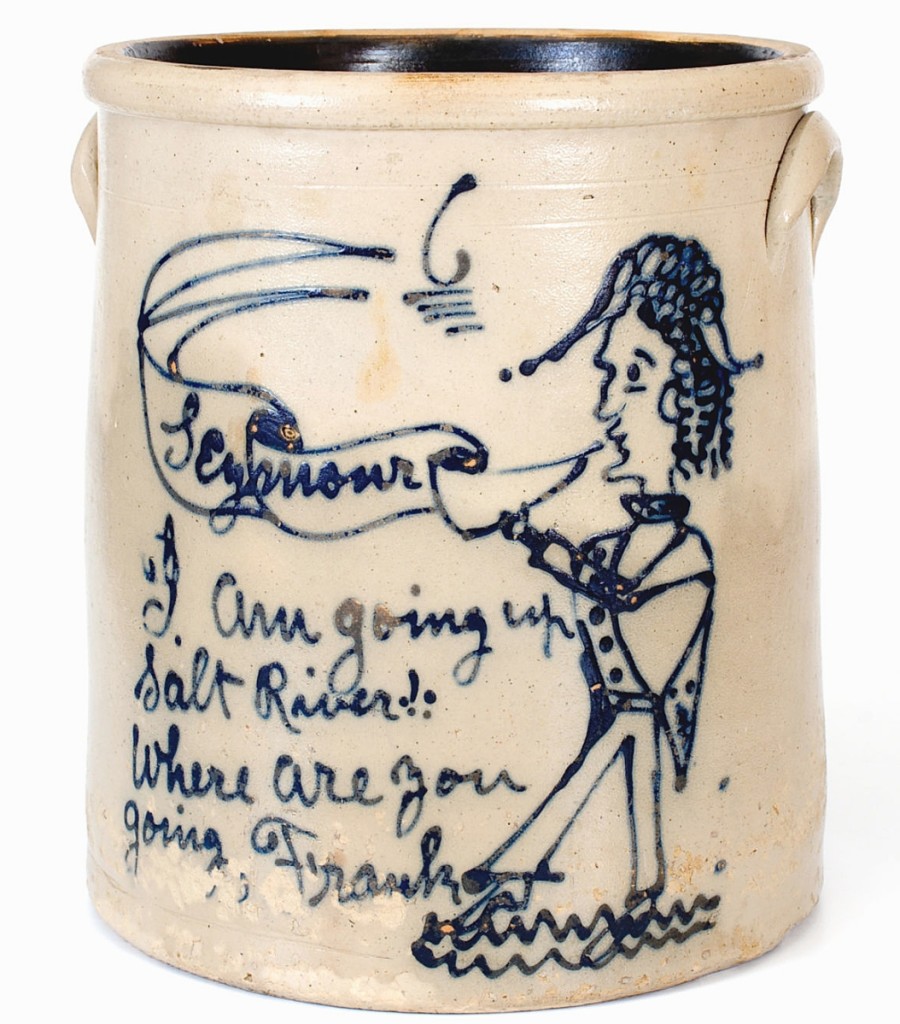
Rising to $20,400 was this 6-gallon stoneware crock from Ohio. It features New York Governor Horatio Seymour wading into Salt River with the inscription “I am going up Salt River! Where are you going, Frank.” Both Seymour and his running mate Francis “Frank” Blair ran as Democrats on a distinctly racist platform in the 1868 election, the first since both the abolition of slavery and also the first where Black people could vote. The phrase “Going Up Salt River” was a euphemism for political loss, a path to nowhere and oblivion. Ulysses S. Grant swept Seymour in a 214-80 electoral decision.
A $24,000 result was had on a stoneware face jug by Paducah, Ky., potter Ernest Galloway, which dated to the early Twentieth Century. Measuring 10 inches high in an Albany slip, the piece featured Galloway’s signature hair part, which he himself is seen sporting in a photograph provided by the auction house. It was “undoubtedly a means by which the jug’s artist…is creating a sort of self-portrait,” the auction house wrote. At only $8,400 was a two-sided stoneware face jug attributed to Henry Harrison Remmey or Richard Clinton Remmey, Philadelphia, Penn., circa 1855-65. The piece was held back due to restoration, Zipp said, who noted that in perfect condition this would be a six-figure prize. He estimated less than 20 Remmey face jugs are known and that this was a great opportunity for a collector to add one to their collection at a relatively reasonable price.
“We had much material in the several thousand-dollar range,” Zipp concluded. “Rare things that were accessible to a wide collecting audience. There was strength throughout on the four-figure pieces and low five-figure pieces. That’s encouraging for the market.”
All prices reported include buyer’s premium. For information, www.crockerfarm.com or 410-472-2016.































